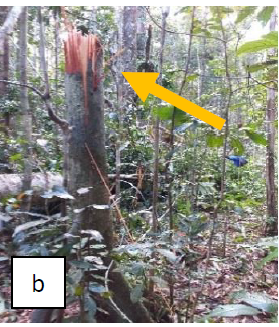Residual Stand Damage Due to Timber Harvesting in PT Tunas Timber Lestari, Papua

Downloads
Timber harvesting activities can cause damage to residual stands, this can occur due to improper timber harvesting techniques. The study was conducted at one of PT Tunas Timber Lestari’s IUPHHK-HA in Papua Province. The results showed that: 1). The number of trees felled and skidded on 3 logging compartment with each of the 3 plot of observation sample has an area of 2 ha (the total area of the research is 18 ha) is 16 trees on average; 2). The average number of residual stand (trees with a diameter of ≥ 20 cm) damaged by logging is 26 trees (13.00%) per ha with details of damage to canopy of 4 trees (15.39%), broken branches of 13 trees (50.00%), the trunk wound of 2 trees (7.69%) and the collapsed/tilted of 7 trees (26.92%); 3). Damage to the residual stand in felling is caused more by the lack of skilled chainsaw operators in determining felling direction; 4) Damage to residual stands due to skidding is an average of 23 trees (9.99%) per ha, with details of 1 trees buttress (4.4%), wounds injuries of 7 trees steam (2.97) and collapsed/slanted 15 trees (65.2%); and 5). The cause of damage to the residual stand on skidding is that the skid trail has not been made and the skid tractor maneuvers too often.
Acuna, E., Sanfuentes, E., Cancino, J., & Mena, P. (2018). Damage to Remaining Trees by Four Systems of Mechanized Harvest in Commercial Thinning of Pinus Radiate. Ciência Florestal, 28(3), 1317-1327.
Britto, P.C., Jaeger, D., Ho_Mann, S., Robert, R.C.G., Vibrans, A.C., & Fantini, A.C. (2019). Impact Assessment of Timber Harvesting Operations for Enhancing Sustainable Management in a Secondary Atlantic Forest. Sustainability, 11 (6272), 1-20.
Cabral, O. M. J. V. (2015). Avaliação operacional da colheita de madeira em desbastes de Pinus taeda L. Dissertaça o (Mestrado em Engenharia Florestal) - Setor de Cie ncias Agra rias, Universidade Estadual do Centro-Oeste, Irati, 110 p.
Dulsalam, Suhartana, S., & Sukadaryati. (2014). Pemanenan kayu di hutan tanaman. Editor: Gustan Pari & Pujo Setio. Bogor: Forda Press. Pp 122.
Dulsalam, Sukadaryati & Yuniawati. (2018). Produktivitas, efisiensi dan biaya penebangan silvikultur intensif pada satu perusahaan di Kalimantan Timur. Jurnal Penelitian Hasil Hutan, 36(1), 1-12.
Eroglu, H., O ztu rk, U.O., So nmez, T., Tilki, F., & Akkuzu, E. (2009). The impacts of timber harvesting techniques on residual trees, seedlings, and timber products in natural oriental spruce forests. African Journal of Agricultural Research, 4(3), 220-224.
Elias. (2008) Pembukaan Wilayah Hutan. Bogor: IPB Press. Pp 300.
Hwang, K., Han, H.S., Marshall, S.E, & Dumroses, D.S.P. (2018). Amount and location of damage to residual trees from cut to length thinning operations in a Young Redwood Forest in Northern California. Forests, 9(352), 1-12.
Jalal, P. S. (2013). Residual stand damage after decreasing on selective cutting diameter (limit of forest conversion) of PT Tri Tunggal Ebony Cooperation Poso District Sulawesi Province. Journal of natural Science Research, 3 (7), 82-89.
Lopes, E.S., Oliveira, F.M., & Droog, A. (2018). Damage to residual trees following commercial thinning by harvester and forwarder in a Pinus Taeda Stand in Southern Brazil. Sci. For., Piracicaba, 46(118), 167-175.
Mawazin (2013). Tingkat Kerusakan Tegakan Tinggal Di Hutan Rawa Gambut Sungai Kumpeh-Sungai Air Hitam Laut Jambi. Indonesian Forest Rehabilitation Journal 1(1), 39-50.
Mirkala, M.R. (2017). Comparison of Damage to Residual Stand Due to Applying Two Different Harvesting Methods in the Hyrcanian Forest of Iran: Cut-to-Length vs Tree Length. Caspian J. Environ. Sci, 15(1), 13-27.
Naghdi, R., Lotfalian, M., Bagheri, I., & Jalali, A. M. (2009). Damages of skidder and animal logging to forest soils and natural regeneration. Croatian Journal of Forest Engineering, 30(2), 141–149.
Piponiot, C., Ro dig, E., Putz, F.E., Rutishauser, E., Sist, P., Ascarrunz, N., Blanc, L., Derroire, G., Descroix, L., Guedes, M.C. (2019). Can timber provision from Amazonian production forests be sustainable? Env. Res. Lett, 14.
RKUPHHK-HA (2010). Inventarisasi Hutan Menyeluruh Berkala PT Tunas Timber Lestari. Papua: PT Tunas Timber Lestari.
Ruslandi. (2013). Penerapan pembalakan berdampak rendah-carbon (RIL-C). Jakarta: The Nature Concervancy.
Silva, D.A., Piazza, G., Fantini, A.C., & Vibrans, A.C. (2018). Forest management in a secondary Atlantic Rainforest: Assessing the harvest damage. Adv. For. Sci. (4), 187–193.
Spinelli, R., Magagnotti, N., & Nati, C. (2010). Benchmarking the impact of traditional small-scale logging systems used in Mediterranean forestry. For. Ecol. Manag, 260, 1997–2001.
Soenarno, Endom, W., Basari, Z., Dulsalam, Suhartana, S. & Yuniawati. (2016). Faktor eksploitasi hutan di sub region Kalimantan Timur. Jurnal Penelitian Hasil Hutan, 34(4), 335-348.
Soenarno, Endom, W., & Bustomi, S. (2017). Kerusakan tegakan Tinggal Akibat Pemanenan Kayu Pada Hutan Tropis Berbukit di Kalimantan Tengah. Jurnal Penelitian Hasil Hutan, 35(4), 273-288.
Soenarno, Dulsalam, Yuniawati, Suhartana, S., & Sukadaryati. (2019). Teknik penebangan pohon hutan alam. Edisi 1. Bogor: IPB Press. Pp. 66.
Stan czykiewicz, A., Sowa, J. M., Kulak, D., Leszczyn ski, K., & Szewczyk, G. (2012). Damage to trees and regeneration layer resulting from timber harvesting with the use of equipment aggregated with farm tractors in thinned pine stands. Acta Sci. Pol. Sil. Colendar. Rat. Ind. Lignar, 11(2), 37–51.
Stan czykiewicz, A., Szewczyk, G., & Kulak, D. (2015). Damage to advance growth resulting from timber harvesting during final cuttings. Baltic Forestry, 21(1), 144–151.
Suhartana, S., & Idris, M.M. (1996). Kondisi tegakan tinggal di kawasan dua perusahaan hutan di Riau. Buletin Penelitian Hasil Hutan, 14(4), 129-137.
Suhartana, S., & Yuniawati. (2015). Peningkatan produktivitas penyaradan kayu Acacia Crassicarpa melalui penerapan teknik ramah lingkungan. Jurnal Hutan Tropis, 3(2), 116-123.
Suwarna, U., Matangaran, J.R & Harmawan, F. (2014). Kerusakan tegakan tinggal akibat pemanenan kayu di hutan alam rawa gambut. Jurnal Manusia dan Lingkungan, 21(1),83-89
Wijayanti, A. (2013). Kerusakan tingkat tiang dan pohon akibat penebangan intensitas rendah di IUPHHK-HA PT. Sari Bumi Kusuma, Kalimantan Tengah, (Skripsi) Institut Pertanian Bogor, Bogor.




